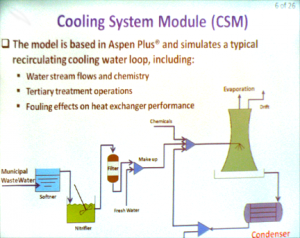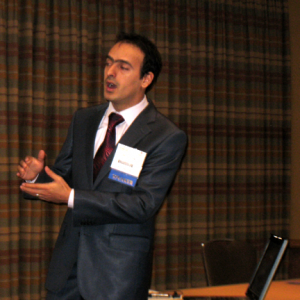
2011 Spring Meeting
With the rise in the world's population and resultant increased need for water in agriculture and power generation, shortages could develop without creative water reuse schemes. One area of high interest is utilizing (post-processed) municipal wastewater for cooling tower make-up in thermoelectric power plants. A detailed study model has been developed and was presented that utilizes advanced computation and modeling techniques to study the cost and performance results from such wastewater utilization.
Model Development
The process modeled involves tertiary treatment of the wastewater with media filtration, and various scenarios using combinations of nitrification, cold lime softening and acidification. The model takes into account:
-

Heat exchanger (condenser) surface degradation, including corrosion, scaling, and fouling.
- Water chemistry effects, including equilibria, reaction rates, and mass transfer performance.
- Process design variables including various tertiary treatments, chemical constituencies and blowdown rates.
- Economic cost factors.
Additional modeling for precipitation (scale salts) and off-gassing (ammonia and carbon dioxide) was also studied and included. The main software programs utilized include OLI and the Aspen + thermodynamic simulator, and Aspen "Custom" was used to model the media filtration unit op.
In any given simulation, the fixed parameters included water flows, inlet and outlet temperature, inlet composition, ambient air temperature, pressure, absolute humidity. The model then calculates mass and energy balances, chemistry effects, mass transfer limits, and performance cost elements.
Model Performance and Future Work

To check the validity of the model, the results obtained were compared to those using the accepted Merkell Method and yielded very similar results. In addition, some preliminary predictions in areas such as the cost of fouling in a 550 mW coal fired power plant ($.5-1.0M) are indicative of the potential value of such a model. Work continues to refine and improve the model (and components) including more detailed water properties' effects, and treatment and CT performance degradation costs among others.
For more information, contact Iman Safari.



Comments
I have worked at a WWTP as the pretreatment coordinator for the past 4 years. What I have been considering is to install some type of contraption to capture the energy of the water that is released from the plant to a nearby creek. The water has to go down concrete steps to aerate it. It would be a great way to capture free power.
I'm not experienced in that sort of thing, but found this site. Looks pretty appropriate. <a href="http://www.hydrovolts.com/" rel="nofollow">http://www.hydrovolts.com/</a> Good Luck! Marty